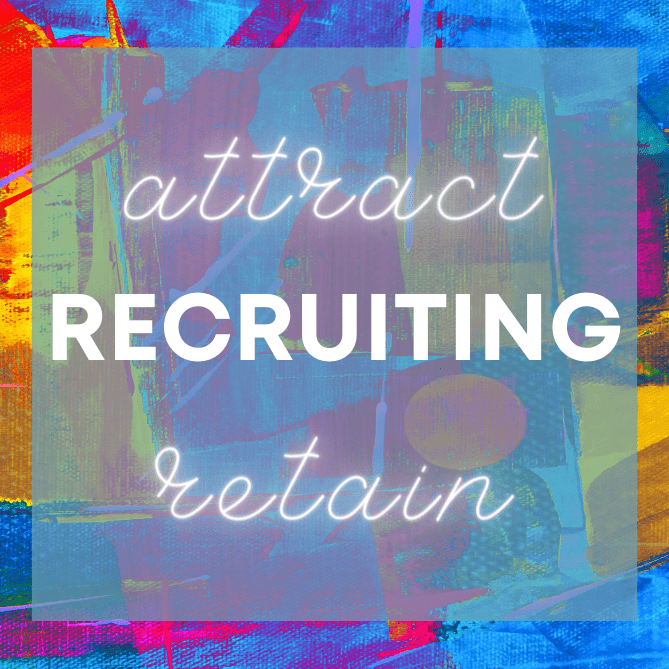Key Takeaways:
1. You are not setting your recruiting process or teams up for success.
2. Most recruiters/hr professionals do not have the time or ability to recruit proactively.
3. Pipelining should be a consistent activity. Be proactive, not reactive, to yield desired results.
Attracting and retaining talent is difficult in a tight labor market. Every company feels the recruiting pain in some way. How painful it is depends on how well you develop and execute your attraction and retention strategies. Execution is everything when recruiting and retaining; you must do the hard work or hire someone to do it for you.
Jim Cusick, Intero’s Talent and Operations Lead, worked with me and contributed to the thinking and design of the content presented here. His expertise in this area is more than technical; it’s highly strategic and gleaned from previous recruiting experience and the gaps and misses many of the people we talk to experience.
Jim and I have several conversations weekly with people who are frazzled, frustrated, and frankly, pretty ticked about recruiting, interviewing, and retaining employees. They are also highly frustrated by ghosting— candidates who don’t even show up. Interestingly, even with the frustration, there seems to be little change in how they recruit.
It’s as though they think this is a talent acquisition and retention blip. It’s just not. The rules have changed. The new rules require fresh thinking, creativity, and a proactive approach that distinguishes you from the packs of companies trying to hold on to old ways of thinking and doing.
We are the first to say that LinkedIn is not the end-all-be-all for attraction and retention; however, it is still the best place to find, attract, and engage talent. Additionally, a hybrid or fully remote working environment is a great way to continue to retain employees.
LinkedIn is the obvious choice for attracting candidates. You can glimpse their credentials, personality, work history, and professionalism within seconds, and you can start a conversation with them almost immediately by simply connecting with them.
Yep, I said it. Connect with me, and start a conversation. Imagine the possibility.
Most leaders and HR professionals do not think of LinkedIn as a place to further woo and retain employees. Too many leaders believe that LinkedIn is where their employees get “poached.” This misnomer is an easy scapegoat that allows business leaders to brush over the real reasons their employees willingly hand in their resignation, turn in their equipment, and go to a “grass is greener” opportunity. Is the grass greener? Probably not, but their current situation is bad enough that it is worth taking the risk.
Some of the most recent data at publication time says that 72% of people regret resigning. This Inc. magazine article outlines what you do not want to be doing as part of your recruiting process unless you are looking for continued high churn.
Attraction and retention go hand-in-hand, and rightly so. A one-in-one-out approach does not solve anything. Losing trained and experienced employees impacts your day-to-day operations, hurting culture, morale, and the bottom line.
Over the past couple of months, I have touched on how the conversations are all around attracting and retaining talent and how different areas of LinkedIn can help you solve the problem. This month I want to highlight how to execute proactive recruitment on LinkedIn. I will use the lens of the internal recruiter or HR professional who is tasked with finding candidates among their many essential responsibilities.
Before you adopt this approach for your business, FIRST ask yourself and your team if you are even giving yourself a chance to succeed.
Here is the average traditional recruiting workflow:
Job Approval
Job Description
Most of the time, a job description is dated, recycled, or cloned from a similar position and contains irrelevant information, is not engaging, and sounds like a thousand other jobs from a thousand other companies.
Post the job
The job description is posted on some applicable job sites and on LinkedIn.
Social media post
A basic “We’re Hiring” image or post is created for LinkedIn that says something to the effect of “we are hiring; if interested, let me know….”
Referrals
HR asks employees if they know anyone interested in the role or offers a $xxx referral fee for submitting people to the position.
Screening
The recruiter or HR person screens candidates by glancing at their LinkedIn profile or resume.
Interview Process
Selected candidates enter the interview process with unclear expectations about the process including the number of interviews.
Selection
A candidate is hired, or the job remains open.
What’s missing from this workflow?
Pipelining
Curating lists of candidates to stay top of mind on LinkedIn so that you can continue talking with them or reconnect with them down the road. Dare I repeat it, remain in light conversation with them.
Prework
Creating dynamic job descriptions that attract candidates and can be used for performance reviews, referrals, and content postings.
Employee Networks
Connecting with all the employees in the company and educating them on how their networks can serve the company’s recruiting initiative is critical.
Actively searching their networks for talent and then reaching out to that employee for an introduction or information about their relationship and if they think they would be a good fit.
Proactive Searches
Leveraging LinkedIn’s premium tools to query a list of potential candidates.
A/B Testing
Create multiple messages and content posts to see what resonates and will perform for you.
Add Creativity
Creativity is specific to each company and position, but creativity is necessary for every search. Some examples are: adapting the job description based on available talent, creating relationships with educators who have students graduating that will eventually want to have the skillsets you need to hire, considering industry adjacent skillsets, and creating video-based job descriptions.
What holds recruiting back from execution?
- Time
- Effort
- Willingness to have lots of conversations
- Lack of proficiency
- Lack of support from the business
- Confidence
The act of pipelining candidates should be a daily activity in an ideal world. Any good marketing or sales team will build momentum over time, and most recruiting/HR teams are not. Are you?
LinkedIn allows you to create a robust pipeline. Do you have a strong talent pipeline?
If you frequently hire for similar skill sets in a market, why are you not actively connecting, saving, and marketing to everyone with those skillsets or prerequisites in your territory?
To execute on LinkedIn, you will need LinkedIn Recruiter or Sales Navigator.
Recruiter Lite is a product that has an infrequent use case. LinkedIn should merge Recruiter Lite and Sales Navigator.
Larger companies, larger recruiting teams, and enterprise-level companies should likely have LinkedIn Recruiter, which allows you to manage your recruiting from the company level, not an individual’s profile/network.
Smaller companies or one-person recruiting teams can be highly successful with Sales Navigator. We have had all of the products and prefer Sales Navigator. The ease of use, affordability, and features make it an easy decision. The “open to work” feature, “job post” integration, built-in applicant tracking system, templated InMail, and “open to relocating” features are nice to have but not necessities when comparing Recruiter to Sales Navigator.
Many companies don’t use LinkedIn Recruiter to its fullest.
Once you have your premium product, you need to spend the time becoming proficient, not just familiar with the tool. There are enough resources and experienced LinkedIn trainers available to help you shorten your learning curve. Not investing the time upfront will impact your efficiency and effectiveness exponentially. LinkedIn is intuitive; the recommendations you receive will be useless if you don’t approach the product the right way and strategically.
After reaching proficiency, network building and strategic searching and saving allow you to build out specific pipelines. Like sales, recruiting requires timing and multiple touches, especially to get the best talent.
The prework is non-negotiable. In establishing pipelines, you can start to engage your target audience, and your passive recruiting activities will become more effective. More candidates will see your posts with a higher number of impressions.
As you know or can glean from the above, workflows and recommendations take a lot of effort, time, and money. If you are not paying placement fees, you are paying an internal recruiter or HR professional a significant salary and benefits. Your investment in hiring is most likely more significant than you think you realize, AND if they are approaching recruiting the traditional way, you are not maximizing your HR investment.
Tactical execution and a strategic plan can lower your overall investment in hiring and improve success.
Another way to lower your investment is to retain the employees that are so hard to find in the first place. Your recruiters or HR professionals should consider retention an integral part of their job.
Yes, retention is a company-wide effort, and your recruiters and HR professionals are uniquely positioned to influence retention. They should have a deep understanding of the company’s authentic culture. The interface with so many team members and management typically has more candid conversations during the hiring process.
Using this access and knowledge paired with LinkedIn can be advantageous for your business. Companies can create camaraderie and company pride on LinkedIn for distributed teams, hybrid work environments, and entirely in-person work environments.
Having a new employee’s profile updated as part of the onboarding process shows a sense of commitment to your employees, and if you use a professional to complete the profile, it’s viewed as an investment in your new hire.
Encouraging employees to invite friends, family, former colleagues, and clients to follow the company page is another way to create a sense of belonging. You do have to be careful with the intent of this practice.
Develop a schedule of company-specific culture-related posts to show your organization’s team pride and camaraderie. When people are respected and belong to almost a sports team-like atmosphere, they will be less likely to listen to that other opportunity or leave for a small pay raise. Couple that with a robust training program, actually adhering to core values, not just using them as empty words, articulating a clear path to career improvement, competitive pay, and substantial benefits. You will start to see a difference in how you retain great people in your organization.
As a leader in your organization, you must understand how to continually improve and innovate your recruiting and retention initiatives.
Do you have the right people to execute? Most likely.
Are you allowing them to be successful? Probably not.
Is your recruiting person or team presenting you with new ideas on how they recruit more effectively? If not, they should be.
Take time to understand the investment for the desired impact on your organization. You will start to pay attention closer to whether you are actually executing or just going through the motions.




